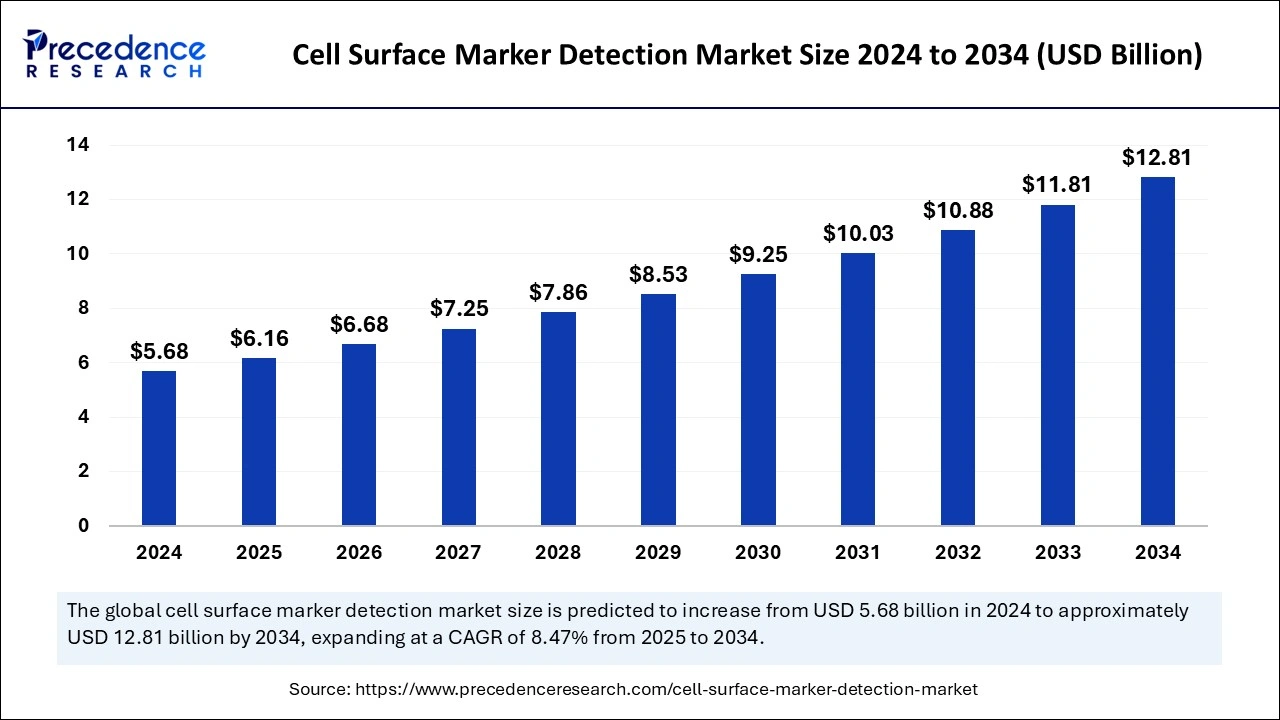The cell surface marker detection market is expected to reach USD 12.81 billion by 2034, up from USD 5.68 billion in 2024, with a CAGR of 8.47%.

Cell Surface Marker Detection Market Key Takeaways
-
In 2024, North America dominated the market, holding a 40% share.
-
Asia Pacific is expected to achieve the highest CAGR of 8.73% throughout the forecast period.
-
The reagents and kits segment accounted for 65% of the total market share by product in 2024.
-
The hematology analyzers segment is projected to expand at a CAGR of 8.3% over the forecast period.
-
By application, the disease diagnosis and identification segment led the market with a 52% share in 2024.
-
The research and drug discovery segment is poised for significant growth during the forecast period.
Cell Surface Marker Detection Market Overview
The cell surface marker detection market is expanding rapidly due to its critical role in immunophenotyping, cancer diagnostics, and stem cell research. Cell surface markers serve as biological signatures that help distinguish different cell types and assess disease progression. The market encompasses various detection techniques, including flow cytometry, ELISA, and PCR-based methods, which are widely used in both research and clinical applications.
Increasing investments in biomedical research and the development of high-throughput screening technologies have contributed to the growing adoption of cell surface marker detection assays in laboratories and hospitals worldwide.
Drivers
The increasing application of immunophenotyping in hematological malignancies and immune disorder diagnostics is a major driver of market growth. Advances in precision medicine have heightened the need for accurate cell profiling techniques, enabling clinicians to tailor treatments based on a patient’s specific cellular characteristics.
The development of next-generation sequencing and multiplex flow cytometry has significantly improved the efficiency of cell marker detection, allowing for simultaneous analysis of multiple biomarkers. Rising public and private sector funding for cancer research and immunotherapy is also fueling demand for sophisticated detection platforms.
Opportunities
Expanding research in regenerative medicine and cell-based therapies presents a major opportunity for the cell surface marker detection market. The development of novel monoclonal antibodies and recombinant proteins for targeted detection is paving the way for more precise and efficient assays.
Collaborations between pharmaceutical companies and diagnostic firms are accelerating the commercialization of innovative detection technologies. The expansion of clinical trials for immunotherapy and CAR-T cell therapy is expected to boost the demand for cell surface marker analysis, as researchers seek to evaluate treatment responses at a cellular level.
Challenges
The high cost of advanced detection systems and the complexity of data analysis pose challenges to market growth. Laboratories require skilled professionals to operate sophisticated instruments and interpret results, which limits accessibility in resource-constrained settings.
Additionally, the lack of standardization in cell marker panels and variations in assay protocols can affect data reproducibility. Regulatory barriers for diagnostic test approvals add another layer of complexity, making it difficult for new market entrants to gain traction.
Regional Insights
The United States and Europe lead the market, with strong research funding, well-established diagnostic laboratories, and increasing adoption of precision medicine.
The Asia-Pacific region is emerging as a key player, driven by growing investments in biotechnology and increasing demand for advanced diagnostic solutions. China and India are witnessing significant market expansion due to rising healthcare infrastructure and government initiatives supporting biomedical research.
The Middle East and Latin America are gradually adopting advanced detection technologies, supported by improvements in healthcare accessibility and disease awareness programs.
Recent Developments
Companies are developing AI-powered flow cytometry platforms to improve the accuracy and efficiency of cell surface marker analysis. New biomarkers are being identified for early cancer detection and personalized treatment approaches.
The integration of machine learning in biomarker discovery is gaining traction, helping researchers uncover novel cellular pathways associated with disease. Several partnerships between biotech firms and academic institutions are driving innovation in diagnostic assay development, accelerating the market’s growth.
Cell Surface Marker Detection Market Top Companies
- Abbott Laboratories
- Danaher Corporation (Beckman Coulter Inc.)
- Becton, Dickinson, and Company
- Bio Rad Laboratories Inc.
- F. Hoffmann-La Roche Ltd
- Diasorin SpA (Luminex Corporation)
- Nihon Kohden Corporation
- Qiagen NV
- Siemens Healthineers
- Thermo Fisher Scientific Inc.
Segments Covered in the Report
By Product
- Flow Cytometry
- Hematology Analyzers
- Reagents & Kits
By Application
- Disease Diagnosis & Identification
- Research & Drug Discovery
- Others
By Geography
- North America
- Europe, Asia-Pacific
- Latin America
- Middle East
- Africa